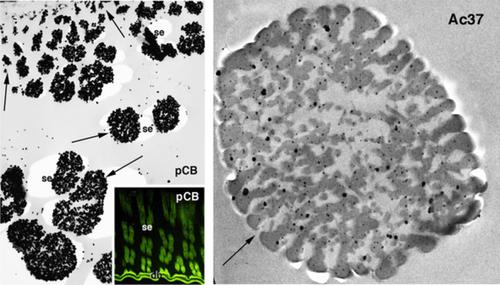当前位置:
X-MOL 学术
›
Microsc. Res. Tech.
›
论文详情
Our official English website, www.x-mol.net, welcomes your
feedback! (Note: you will need to create a separate account there.)
Immunolocalization of corneous proteins including a serine-tyrosine-rich beta-protein in the adhesive pads in the tokay gecko.
Microscopy Research and Technique ( IF 2.0 ) Pub Date : 2020-04-09 , DOI: 10.1002/jemt.23483 Lorenzo Alibardi 1
Microscopy Research and Technique ( IF 2.0 ) Pub Date : 2020-04-09 , DOI: 10.1002/jemt.23483 Lorenzo Alibardi 1
Affiliation

|
Adhesive pads of geckos contain many thousands of nanoscale spatulae for the adhesion and movement along vertical or inverted surfaces. Setae are composed of interlaced corneous bundles made of small cysteine‐glycine‐rich corneous beta proteins (CBPs, formerly indicated as beta‐keratins), embedded in a matrix material composed of cytoskeletal proteins and lipids. Negatively charged intermediate filament keratins (IFKs) and positively charged CBPs likely interact within setae, aside disulphide bonds, giving rise to a flexible and resistant corneous material. Using differernt antibodies against CBPs and IFKs an updated model of the composition of setae and spatulae is presented. Immunofluorescence and ultrastructural immunogold labeling reveal that one type of neutral serine‐tyrosine‐rich CBP is weakly localized in the setae while it is absent from the spatula. This uncharged protein is mainly present in the thin Oberhautchen layer sustaining the setae, although with a much lower intensity with respect to the cysteine‐rich CBPs. These proteins in the spatula likely originate a positively charged or neutral contact surface with the substrate but the influence of lipids and cytoskeletal proteins present in setae on the mechanism of adhesion is not known. In the spatula, protein‐lipid complexes may impart the pliability for the attachment and adapt to irregular surfaces. The presence of cysteine‐glycine medium rich CBPs and softer IFKs in alpha‐layers sustaining the setae forms a flexible base for compliance of the setae to substrate and improved adhesion.
中文翻译:

角质蛋白的免疫定位,包括在tokay壁虎的粘着垫中富含丝氨酸-酪氨酸的β-蛋白。
壁虎的胶垫包含成千上万的纳米刮铲,用于沿垂直或倒置表面的粘附和移动。刚毛由交织的角质束组成,交织的角质束由富含半胱氨酸-甘氨酸的角质β蛋白(CBP,以前表示为β-角蛋白)制成,并嵌入由细胞骨架蛋白和脂质组成的基质材料中。带负电的中间丝角蛋白(IFK)和带正电的CBP可能会在刚毛内相互作用(除了二硫键),从而形成一种柔软而耐久的角质材料。使用针对CBP和IFK的不同抗体,展示了刚毛和小铲组成的更新模型。免疫荧光和超微结构免疫金标记显示,一种中性丝氨酸-酪氨酸丰富的CBP在刮刀中较弱,而刮刀中则不存在。这种不带电荷的蛋白质主要存在于维持刚毛的薄薄的Oberhautchen层中,尽管相对于富含半胱氨酸的CBP而言强度要低得多。刮铲中的这些蛋白质可能与底物形成带正电或中性的接触表面,但尚不清楚刚毛中存在的脂质和细胞骨架蛋白质对粘附机理的影响。在刮铲中,蛋白质-脂质复合物可赋予附着力柔韧性并适应不规则表面。
更新日期:2020-04-09
中文翻译:

角质蛋白的免疫定位,包括在tokay壁虎的粘着垫中富含丝氨酸-酪氨酸的β-蛋白。
壁虎的胶垫包含成千上万的纳米刮铲,用于沿垂直或倒置表面的粘附和移动。刚毛由交织的角质束组成,交织的角质束由富含半胱氨酸-甘氨酸的角质β蛋白(CBP,以前表示为β-角蛋白)制成,并嵌入由细胞骨架蛋白和脂质组成的基质材料中。带负电的中间丝角蛋白(IFK)和带正电的CBP可能会在刚毛内相互作用(除了二硫键),从而形成一种柔软而耐久的角质材料。使用针对CBP和IFK的不同抗体,展示了刚毛和小铲组成的更新模型。免疫荧光和超微结构免疫金标记显示,一种中性丝氨酸-酪氨酸丰富的CBP在刮刀中较弱,而刮刀中则不存在。这种不带电荷的蛋白质主要存在于维持刚毛的薄薄的Oberhautchen层中,尽管相对于富含半胱氨酸的CBP而言强度要低得多。刮铲中的这些蛋白质可能与底物形成带正电或中性的接触表面,但尚不清楚刚毛中存在的脂质和细胞骨架蛋白质对粘附机理的影响。在刮铲中,蛋白质-脂质复合物可赋予附着力柔韧性并适应不规则表面。











































 京公网安备 11010802027423号
京公网安备 11010802027423号